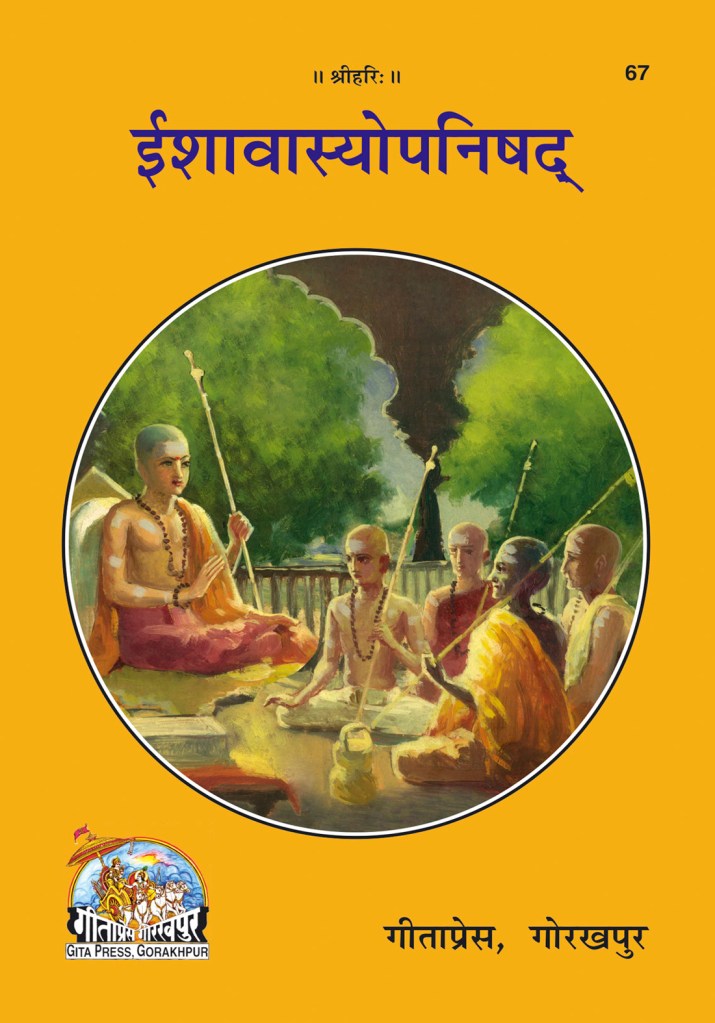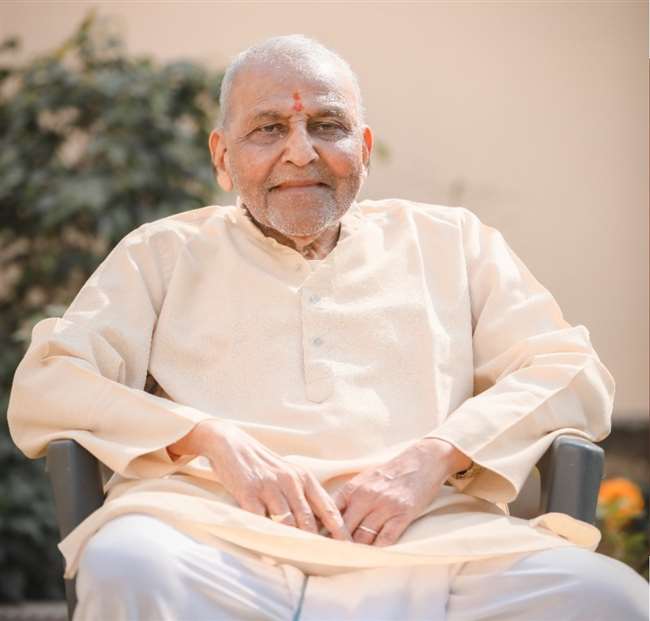
To indicate its proper pronunciation it is written as īśā. Most commonly it is written simply as Isha. Except for the title I will also stick to Isha so that my post is not left out of SEO benefits. But, since in Devanagari it is written as ईशा it should be written in Roman alphabets as Eesha when we don’t use the pronunciation indicators.
Since, as a rule, I will not be repeating a text of the same category in this AtoZ series and Isha Upanishad is my representative book for the Upanishads it will not be out of place to give a brief introduction about Upanishads.
Accounts vary ranging from 108 to 200 as far as the number of Upanishads are concerned. Accounts also vary from 10 to 13 as to the number of Upanishads which are considered as the Principal Upanishads. These Principal Upanishads are parts of different Vedas. Upanishads contains discussions about the ultimate reality and the ultimate goals of human life. Since Upanishads marked the conclusion of vedic activities these are also known as Vedanta.
The ritualistic parts of the Vedas are known as Karmakanda and the contemplative part comprising of the Upanishads are known as the Jnanakanda. Karma and Jnana complement each other and without one the other is incomplete. It is interesting to see that some stanzas the Upanishads outright condemn religious rituals. Yet, these are part of the books which are mostly about rituals. I will take up this issue of such contradictions in a later post.
Isha Upanishad starts with the words Ishavashya, hence the name Isha Upanishad. According to some it is the first Upanishad. It is also one of the smallest- only 18 verses. Or 17 according another version. This number excludes the shanti patha or the seed mantra which is usually recited at the beginning and at the end of the Upanishad. You might have somewhere come across the seed mantra of Isha Upanishad. It goes like this:
Om Purnamadah purnamidam purnat purna mudachyate Purnashaya purnaamdaya purnamebabashisyate
I have already written a blog post about the seed mantra of Isha Upanishad. In case you are interested to understand the meaning of this often quoted sloka, please visit the post. Purnat purna mudachayate finds mention in the logos / mottoes of many educational institutes.
Another extract of Isha Upanishad that finds mention in a chain of educational institutes, i.e the Kendriya Vidyalayas run by the Government of India, is ‘tatvam pushan apavrinu‘. It is taken from the 15th sloka of Isha Upanishad which goes as follows:
हिरण्मयेन पात्रेण सत्यस्यापिहितं मुखम्। तत् त्वं पूषन्नपावृणु सत्यधर्माय दृष्टये ॥ hiraṇmayena pātreṇa satyasyāpihitaṁ mukham | tat tvaṁ pūṣannapāvṛṇu satyadharmāya dṛṣṭaye || The face of the pot of truth is covered with a golden lid; O Pushan, remove it so that we can see the truth for the sake of dharma.
There are thousands of interpretations of Ishavashya Upanishad. 99% of them are either very ambiguous about this sloka or knowingly twist it to fit in with the basic philosophy of their sect. Belonging to a sect is very attractive. One can get lost in the pleasure of belongingness. The pleasure of belongingness can sometimes be a golden covering that keeps you away from the truth.
Rather than the mundane activities, it is the golden coverings which are more dangerous for a seeker of truth. In puranas whenever a Rishi was in his final stage of self realization, Indra used to send the most beautiful women – the apsaras. Some Rishis thought it was the result of their tapascharya and fell prey to these ploys. Some found it difficult to resist the temptation, forgetting that it was just a golden veil. If they got attached to the golden veil it would be very difficult for them to get to the truth. With so many humane weaknesses, it is extremely difficult a human being to ignore and go past the golden veil. Hence the prayer for additional help. Prayer also makes one humble and takes away the egoistic feeling that one is enough unto oneself to overcome the obstacles to truth.
The second part of the sloka is vey important. Many interpreters miss it – some of them by following someone else’s wrong translation.
To summarise, the seeker here says three things:
1. The pot of truth is covered by a golden veil which implies that the pot of truth is attractive but the greedy will not dare to tear it and there are chances he will just preserve it without ever exploring what is inside. In south Indian Temples the Gopuram is very attractive. But if you are struck with the beauty of the Gopuram you miss the deity inside the Garbhagriha.
2. Human beings are not enough unto themselves when it comes to discovering the ultimate truth. The paradox is that if they think they are enough unto themselves their ego keeps them away from the truth. So Pushan or the Sun God that lights every thing is invoked to throw light and help the seeker.
3. The seeker is seeking truth to use it for dharma and not to misuse it. History is of full of examples as to how those who knew the truth often misused it for selfish ends, quite often with disastrous consequences. Many of the scientific inventions were first used for military purposes. So after knowing the truth there are chances that the seeker may use it for adharma. Hence the seeker is kind of giving an assurance that he will use it for dharma.
Upanishads have been the favourite text for many western scientists including Erwin Schrodinger. When scientists observed the subatomic particles they were stunned by their behaviour. Some of them moved yet seemed to be static. Some of them were here and suddenly appeared at another place without leaving any trace of their path. Here I am reminded of the 5th sloka of Isha Upanishad:
तदेजति तन्नैजति तद् दूरे तद्वन्तिके। तदन्तरस्य सर्वस्य तदु सर्वस्यास्य बाह्यतः ॥ tadejati tannaijati tad dūre tadvantike | tadantarasya sarvasya tadu sarvasyāsya bāhyataḥ || That moves and that moves not; that is far and that same is near; that is within all this and that also is outside all this.
Isha Upanishad also sets the foundational difference between Vedanta and Buddhist philosophy. Buddhist philosophy is based on Sunyabaad – ultimately there is nothing in anything. Things come from nothing and go back to nothing. To the contrary according to Vedants everything is filled with Brahman. The first sloka of the Ishavashya Upanishad sets the tone for this:
ईशा वास्यमिदं सर्वं यत्किञ्च जगत्यां जगत्। तेन त्यक्तेन भुञ्जीथा मा गृधः कस्यस्विद्धनम् ॥ īśā vāsyamidaṁ sarvaṁ yatkiñca jagatyāṁ jagat | tena tyaktena bhuñjīthā mā gṛdhaḥ kasyasviddhanam || All this - whatever is moving or static in this universe - is pervaded with Isha Enjoy but with a sense of renunciation. Don't be greedy. After all, whose is all this wealth?
The whole universe is pervaded with Isha. Basic constituent of everything whether living or non-living is Isha. The sloka further goes on to add that there should be a balance between spiritual and material life, individual and social life. Enjoy, but don’t abandon the sense of renunciation. Care for yourself but don’t forget your role in society. Enjoy, but don’t get attached to anything. Enjoy with a sense of trusteeship. Anyway you are not the permanent owner of anything.
************************
Other Mukhya (principal) Upanishads are : Kena Upanishad / Katha Upanishad / Prasna Upanishad / Mundaka Upanishad / Mandukya Upanishad / Taittiriya Upanishad / Aitareya Upanishad / Chhandogya Upanishad / Brihadaranyaka Upanishad / Svetasvatara Upanishad / Kausitaki Upanishad / Maitrayaniya Upanishad
This is the fifth post (alphabet E post) of Blogchatter AtoZ Challenge 2021. My theme this year is ‘The beauty of Sanskrit and Sanskrit texts’, where in I explore selected compositions in Sanskrit and also some unique aspects of Sanskrit language. Join with me in my journey to understand India’s spiritual and intellectual heritage. All the posts of AtoZ Challenge 2021 can be accessed here.
**************************

When it comes to preservation, publication and popularisation of Sanskrit texts, the Gita Press, Gorakhpur has played the leading role for close to a century. It is heartening to note that its Chairman Radheshyam Khemka pased away a couple of days back. He also edited many popular periodicals of the publishing house. My heartfelt condolences for the noble soul.
Wow! The way you explained the shlokas is so enlightening. Thanks for imparting your knowledge. Beautiful post.
LikeLiked by 2 people
Happy that you liked the post. Thanks
LikeLiked by 1 person
What a beautiful explanation. The way you explained the second part of the shlok comparing it to gopuram it was just wonderful. So apt to make one understand. Also liked things come from nothing and go back to nothing
So much to gain from your posts
Deepika Sharma
LikeLiked by 2 people
Happy that the post is useful. Thanks.
LikeLiked by 1 person
For someone young and new to this would gain a lot from your posts!
You explained it so well.
LikeLiked by 2 people
Thank you
LikeLike
The Upanishads are a rich source of ethereal wisdom.
LikeLiked by 2 people
So true. Thanks for stopping by.
LikeLike
The context of the golden cover on the pot of truth is so apt. We can clearly witness the evidence in our day-to-day life. Material distractions always come in the way of acquiring knowledge. ‘Aham’ (ego) restraints and limits the amount of wisdom you can absorb and those who have misused the power of knowledge have always faced consequences sooner or later.
LikeLiked by 2 people
Of course karma ultimately catches up with those who misuse knowledge.
LikeLike
This is such a detailed post for someone like me who is new to this world. Kudos to your efforts to have taken up this daunting task of exploring the rich treasure of Sanskrit that is ever available to mankind.
LikeLiked by 2 people
Thank you so much
LikeLiked by 1 person
That’s a wonderful project for AtoZ challenge, needs extensive research and kudos to you for taking it up and imparting it such a meaningful way.
As you said, I have some across the slokas. Our rich cultural heritage is explored by the West in such minute detail while we ourselves care less. Thanks for bringing it to us in such nuggets.
LikeLiked by 2 people
Sometimes as Indians we neglect our own heritage that is full of wonder. Thanks for stopping by.
LikeLiked by 1 person
Sir
You are right. As Indians, we neglect our own heritage. I am going through the post. Now a days, rarely people read Upanishads. You are writing on Upanishads and reaching out to people. It is a great job.
My best regards.
ARUN KUMAR SINGHA MAHAPATRA. 🙏
LikeLiked by 1 person
I studied in Kendriya Vidyalayas and recited the shlokas. Gita Press publishes excellent books, I used to buy a lot of them from their stall at Nizamuddin station in Delhi. Last I heard, they are closing down. I hope it’s not true.
LikeLiked by 2 people
Gita Press is in very bad shape. But it is still running.
LikeLiked by 1 person
Wow sir this is such a gem of a post… A true delight to read understand and absorb the meanings of the shlokas you have explained so beautifully… I will save this post to keep coming back to it.
LikeLiked by 2 people
Happy that you loved the post. As a poet you will definitely be able to relate with the Upanishads better.
LikeLiked by 1 person
Very well-explained.
Such a scholarly piece. There is so much that we need to learn…
LikeLiked by 2 people
Thank you
LikeLiked by 1 person
You have nicely explained and made it easy for a seeker of truth.
My best regards 🙏
LikeLike